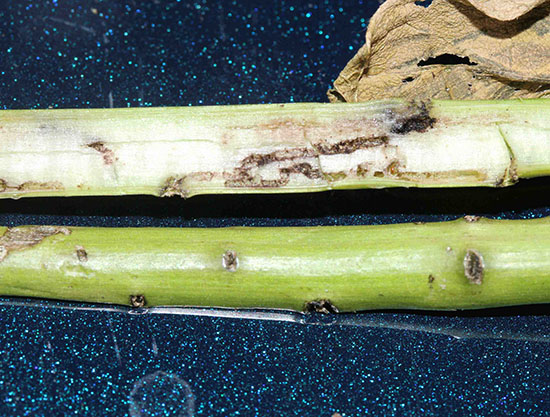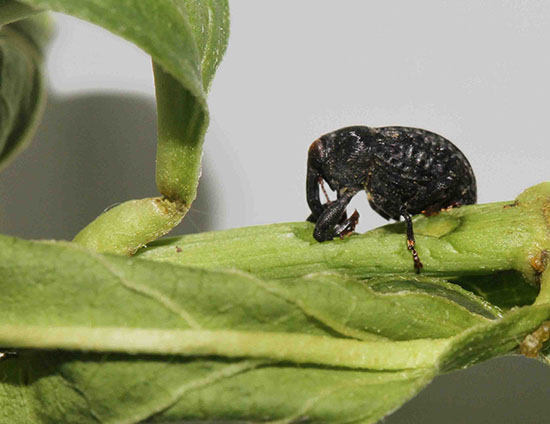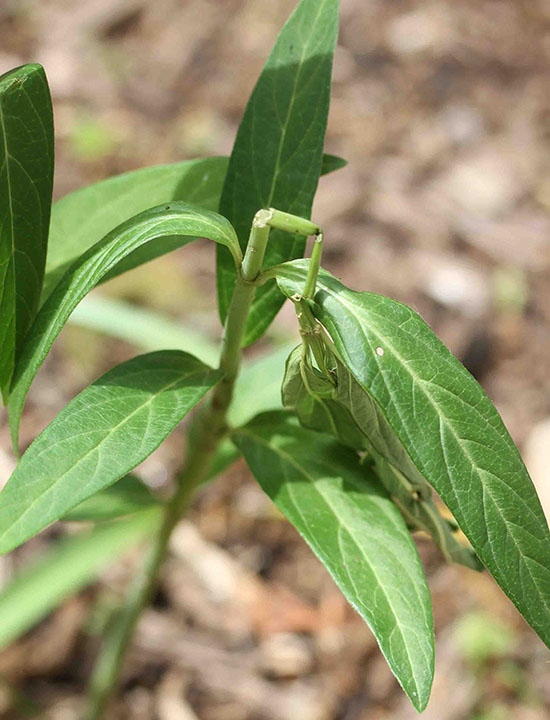Issue 6, June 1, 2015
Milkweed Weevils
Milkweeds are becoming popular in ornamental plantings not only for their beauty as flowering plants but also as food sources for monarch caterpillars. A reduction of host plants is thought to be a major factor in the decline over the last few years in the number of monarch butterflies. Although numerous insects feed on milkweeds, most of them do not seriously damage the plants and are also colorful additions to the landscape. Exceptions to this are two drab weevil species that cause serious dieback of the plants and reduce seed production.
Rhyssomatus lineaticollis is commonly referred to as the milkweed weevil. Adults are blackish and almost one-quarter inch long. They have dark red antennae and tarsi (foot sub-segments), and the front of the head is prolonged into an obvious snout that is directed downwards when feeding. Adults emerge in May and are present into early July. This species feeds on common milkweed, Asclepias syriaca, and Mead's milkweed, A. meadii, a federally threatened species. The adults feed at night on the young leaves and growing tips of common milkweed when they emerge in the spring. They also feed on leaf midribs.
They lay eggs in the stem near the base of the plant, chewing a vertical series of holes resulting in a three-fourths to one-and-one-half inch long slit that commonly fills with milkweed latex and turns black. Eggs are laid in about a third of these holes, being deposited between the vascular tissue and the pith.
The whitish, legless, hatching larvae feed in the pith, being restricted to a single internodal space. Apparently, they are unable to move past the node. Large numbers of larvae are commonly present, greatly weakening the stem. Mature larvae are about one-half inch long and apparently leave the stem, drop to the soil and pupate. Some of these emerge as adults later in the summer that lay eggs in common milkweed pods, hatching into larvae that feed on the developing pod wall, internal spongy tissue, and the developing seeds. Mature larvae leave the pod and drop to the soil to pupate. They emerge as adults about two weeks later, feeding on milkweeds before hibernating for the winter.

Milkweed weevil larval tunneling damage.
Rhyssomatus annectans adults are similar in size and appearance to R. lineaticollis, but are more slender. Dorsally on the thorax behind the head, there are many low parallel ridges that are longitudinal on R. lineaticollis but are oblique, strongly angling outward, on R. annectans. An easier method of identification is that R. annectans attacks swamp milkweed, A. incarnata, rather than A. syriaca.
Adults also emerge in May and are nocturnal like R. lineaticollis. They feed on the midvein of terminal leaves, causing the leaves to be distorted. They also eat a series of holes in the stems of swamp milkweed, into some of which they lay eggs. This damage to the stem causes the upper stem and leaves of the plant to wilt and break off. Hatching larvae create meandering tunnels through the pith, and numerous older larvae consume the entire pith. Mature larvae pupate in the pith with first generation adults emerging in mid-summer through round holes that they chew in the stems.

Milkweed weevil adult feeding on incarnata stem.
In late August and early September, adults chew holes in swamp milkweed pods to lay eggs just under the pod wall. These small holes are easy to find because the green pod tissue surrounding the hole turns red. The resulting larvae feed on the developing seeds, creating a mass of feces and webbing that prevents proper dispersal of unattacked seeds. During the first half of October, the adult weevils leave the pod, apparently overwintering in the soil.

Milkweed weevil adult stem feeding damage.
These weevils appear to be excellent fliers as large numbers of R. lineaticollis adults have been found in boll weevil pheromone traps in Texas. These traps are typically placed four feet off the ground on stakes. The use of these traps may be a method to reduce the number of milkweed weevils and thus reduce damage. Placement of high numbers of Gypsy moth traps have been successful in northern Illinois in reducing Gypsy moth larval numbers probably by confusing males through excessive pheromone release, resulting in reduced mating.
Because these two weevils appear to be somewhat host specific, crop rotation may be a viable option in landscape plantings. Although these are perennial plants, removal of attacked milkweed species for a year or two should drastically drop the weevil population, allowing susceptible milkweed species to be grown for several years until weevil populations build to unacceptable levels. Similar adult feeding damage observed in A. tuberosa may be an indication that these weevils survive in small numbers on other milkweed species, thwarting any crop rotation plans.
In natural areas, crop rotation is not feasible as milkweeds in surrounding areas will provide numerous invading weevils. Similarly, elimination of the threatened A. meadii in areas as a host for R. lineaticollis is not only ill-advised but illegal as a federally threatened species. Control with insecticides does not appear to be feasible without additional research due to their likely effects on other favored insect species. (Phil Nixon)
Author:
Phil Nixon